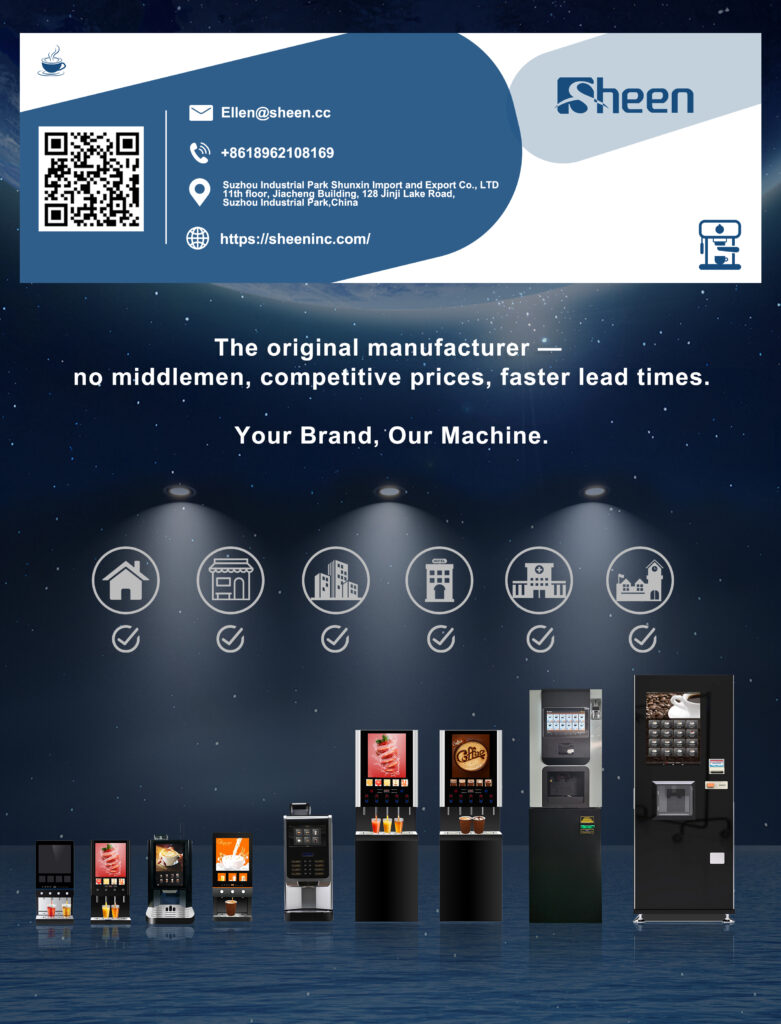As a coffee machine export manager who’s spent over a decade matching clients with the right equipment—from Parisian cafés to Tokyo’s 24-hour convenience stores—I’ve learned that “vending coffee machines” aren’t one-size-fits-all. These automated wonders range from sleek single-cup wonders to industrial behemoths that keep airports humming. Let’s break down the key types, their strengths, and where they shine globally, based on real-world client stories and trade show insights.

1. Single-Serve Pod/Capsule Machines: Convenience at Your Fingertips
Let’s start with the heavy hitters: pod and capsule machines. Think Nespresso Vertuo or Keurig K-Classic. These are the “grab-and-go” stars of offices, hotel lobbies, and even some home kitchens. Here’s how they work: pre-portioned coffee pods (either proprietary or third-party) are inserted, water is heated, and a single shot is brewed in under a minute.
Why buyers love them: Low maintenance, minimal training, and near-zero waste (if using recyclable pods). A client in Dubai recently ordered 50 of these for a new hotel chain—they needed machines that could handle 24/7 demand without a barista. The catch? Dependency on proprietary pods can limit brand flexibility, and consumers are increasingly pushing for eco-friendly alternatives (like compostable capsules).
2. Fresh-Bean Grind-and-Brew Machines: The “Artisan” Vending Option
For buyers wanting to cater to coffee snobs, fresh-bean machines are the way to go. These units grind whole beans on-demand, extract espresso, and often include milk frothers for lattes or cappuccinos. Brands like La Marzocco’s Linea Mini or Slayer’s One Group have popularized this category.
Key features: They mimic café-quality brews, with adjustable grind size, water temperature, and extraction time. A client in Seoul used these in high-end office buildings—their tech-savvy tenants loved that they could choose between single-origin beans or seasonal blends. But beware: higher upfront cost, frequent bean refills, and more intensive cleaning (grind burrs, milk lines) mean they’re best for locations with steady foot traffic and a budget for maintenance.
3. Bulk Brew Dispensers: For High-Volume, No-Frills Demand
If you’re equipping a gym, university campus, or corporate cafeteria, bulk brew machines are the workhorses. These units brew large quantities of drip coffee (think 10–20 cups at a time) into insulated tanks, keeping it warm for hours. Some even offer flavor shots (vanilla, caramel) via separate dispensers.
What sets them apart: Speed and scalability. A client in Mexico City installed these at a busy metro station—they serve 300+ cups daily, and the bulk system means less downtime between refills. The trade-off? Less customization (no latte art, limited to black or flavored coffee) and occasional “stale” taste if the tank isn’t cleaned daily.
4. Smart Connected Machines: The IoT Revolution
The latest trend? Coffee vending machines with Wi-Fi and app integration. Brands like Brigitta or US-based Bravilor Bonamat now offer models where users can order ahead via an app, pay digitally, and even customize their drink (extra shot, oat milk). For operators, these machines send real-time alerts when beans run low, filters need changing, or the tank is empty.
A recent case: A client in Singapore deployed smart machines in a co-working space. Tenants loved pre-ordering their morning coffee on the way in, cutting wait times to under 30 seconds. The data from the machines also helped them adjust inventory—less waste, more profit. But expect higher costs (both for the machine and tech support) and reliance on stable internet.
Global Preferences: What Sells Where
- Europe: Single-serve capsule machines dominate urban areas (Italy, France), but fresh-bean models are rising in Germany, where “coffee culture” leans toward quality.
- North America: Bulk brewers rule offices and universities, while smart machines are gaining traction in cities like New York and Toronto (where convenience meets tech love).
- Asia: Capsule and smart machines thrive in Japan and South Korea (fast-paced, tech-obsessed markets), while bulk brewers dominate rural areas or budget-conscious chains.
The Buyer’s Checklist: What to Ask Before Investing
As someone who’s helped hundreds of clients choose, here’s my pro tip: Match the machine to the location’s usage pattern. A busy airport needs fast, high-capacity bulk brewers. A boutique hotel? Single-serve or fresh-bean for that “luxury” feel. And always factor in local preferences—consumers in Brazil, for example, prefer sweeter, milk-heavy drinks, so milk-frothing capabilities matter more there.
From the first pod inserted to the last drop dispensed, vending coffee machines are more than just appliances—they’re bridges between convenience and quality. Whether you’re a café owner, a corporate buyer, or a retailer, understanding these types is key to meeting your customers’ caffeine cravings.
Stay grounded in the grind, and keep exploring what makes each machine tick.
Welcome to Sheen’s Blog, where we decode coffee tech, share sourcing hacks, and help you find the perfect vending machine for your business. Ready to upgrade your fleet or explore custom models? Drop us a line—we’ve got the expertise, inventory, and trade insights to make your next project a brew-tiful success. ☕️🤖

